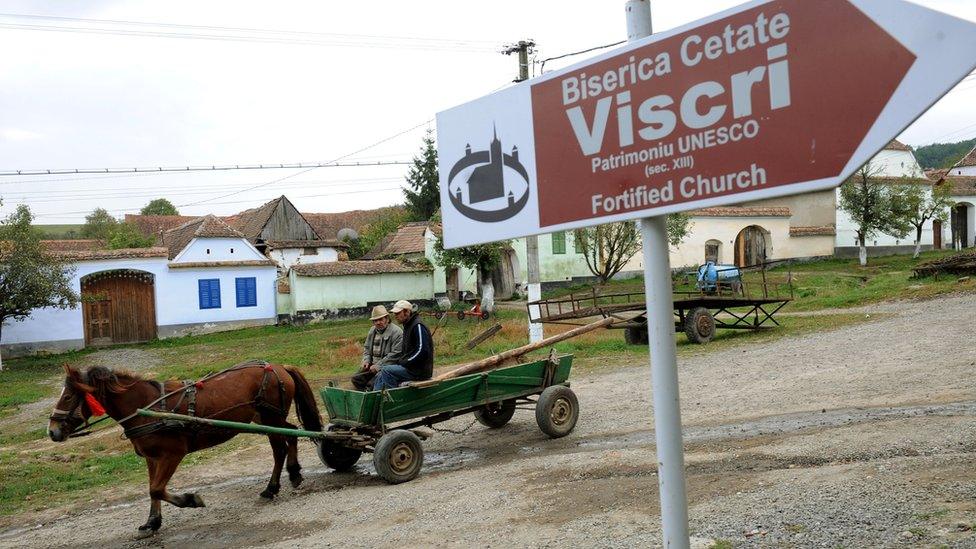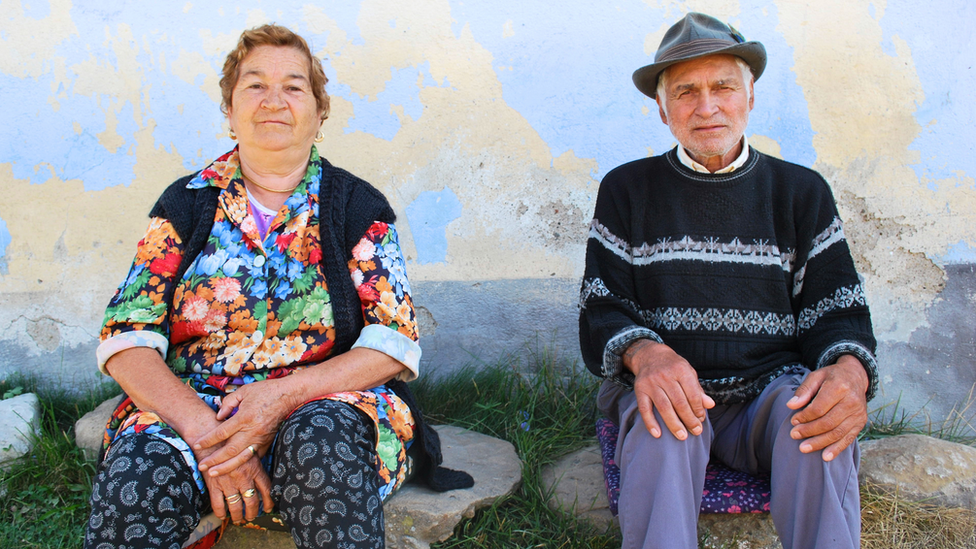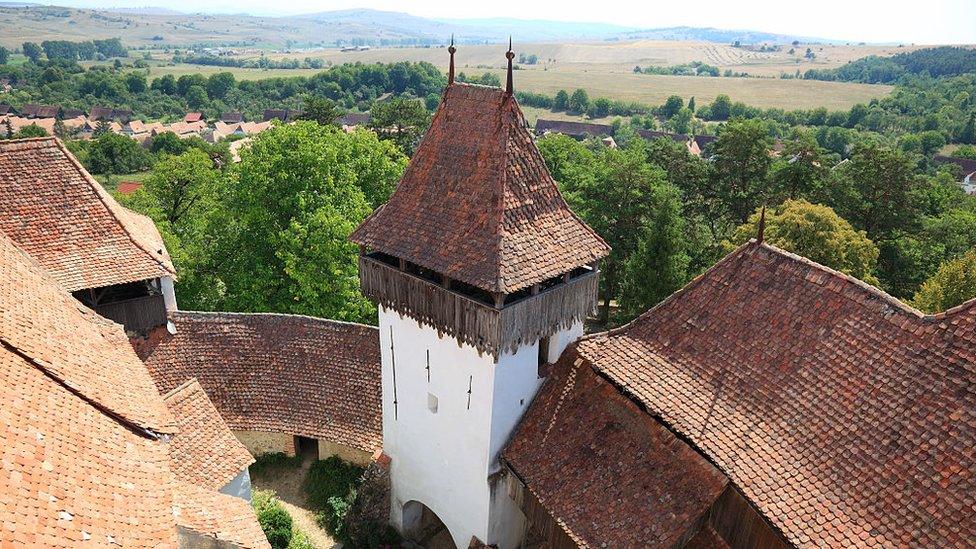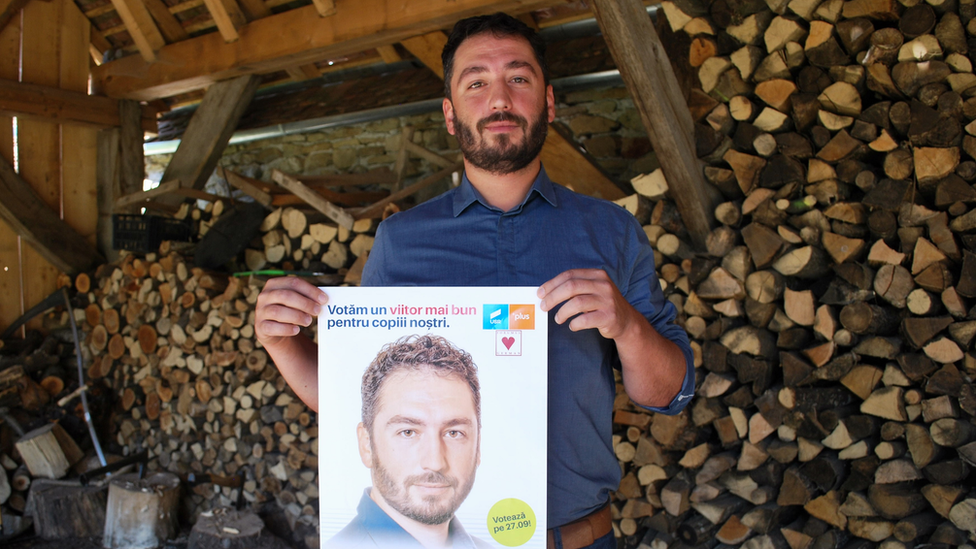Romanian tourists swamp village loved by Prince Charles
- Published

The village of Viscri has seen a steep increase in visitors in recent years
Only 450 people live in the remote village of Viscri in central Romania, but in recent months it has become overrun by tourists and their cars.
It is arguably the most popular village in Transylvania. Not only is it a Unesco World Heritage site but the Prince of Wales has owned a traditional farmhouse here since 2006.
The prince fell for the area's historic beauty more than two decades ago. For years he has helped develop schemes to preserve heritage architecture and what his local foundation describes as a "way of life unchanged for hundreds of years".

It is a scorching Saturday at the tail end of summer, and a steady stream of cars is filing into Viscri. There is a trail of noise and dust as traffic begins to clog up the unsurfaced village roads.
"Look at the dust coming from the road!" exclaims Irina Lascu. "It's really disturbing us, we can't even open our windows."
"Cars are going past from early morning until late in the evening," says Martin Lascu, who has lived in Viscri since he was born in 1945.

Martin and Irina Lascu have struggled with the rise in tourists in the village
Sitting outside their traditional farmhouse, Irina and Martin, both 76, are clearly exasperated by the droves of tourists descending on their village.
"Everyone is coming because of Prince Charles," Martin complains.
A constant cluster of tourists lingers outside the prince's blue house to take photographs.
It is a simple, traditional Saxon farmhouse like any other, distinguished by features such as broad wooden gates and clay roof tiles. Part of the house dates back to the 18th Century.

The prince has launched a foundation aimed at preserving historic buildings, helping farmers and local businesses
Rooms can be rented for around €100 (£90; $120) per night.
'A blessing and a curse'
Over the past few years Viscri's popularity has grown significantly and so too have the tourist numbers.
Last year, 45,000 tourists bought admission tickets to Viscri's remarkable 12th-Century fortified Lutheran Church. That compares with 15,000 in 2015 and 5,000 in 2005.
This year, Covid-19 restrictions on travel abroad have prompted an increase in domestic tourism, and with it more cars.

Viscri's fortified church is a Unesco World Heritage Site
But other than the church, people are also drawn by the prince's house.
Ursula Radu-Fernolend, 35, is a Saxon (descendant of settlers from present-day Germany) whose ancestors have lived in Viscri for centuries. She's also a board member for the Mihai Eminescu Trust (MET), which for 20 years has played a key role in preserving the village's architecture.
For her the prince's influence here has been a "blessing and a curse".

The Prince of Wales visiting Viscri in 2017
For years, the prince was a patron of MET until he withdrew his support in 2014.
In 2015, he launched the Prince of Wales Foundation Romania, external, which focuses on preserving heritage architecture, supporting smallholder farmers and helping to develop sustainable businesses.
We need to have an integrated approach to rural development. I happen to think the small farmer, the smallholder, is absolutely crucial to the maintenance of food security

Training and education is offered, in what the prince has referred to as "an extraordinary part of the world". He has praised the landscape and biodiversity created by "man's management and relationship with nature".
The BBC approached the foundation to comment on the increase in tourists but it declined.
Holiday home hotspot
Over the past few years Viscri has become what Ms Radu-Fernolend describes as a "tick-the-box tourism" destination.
As Viscri's popularity has grown, it has become a holiday home hotspot for cosmopolitan foreigners and wealthy Romanians. It is also a desirable destination for entrepreneurs from Bucharest to open guesthouses and restaurants.

Ursula Radu-Fernolend says house prices in the village have "exploded"
As a result, house prices have risen dramatically. A house that would have cost €20,000 (£18,000; $23,500) in 2010 could now be sold for upward of €80,000.
"House prices have exploded," Ms Radu-Fernolend says. "It's really a real estate bubble. Vicinity to Viscri drives up house prices in neighbouring villages."
Locals who grew up in the area will struggle to buy a home, she believes, and foreign ownership may need regulating.
But if there's one issue that unites Viscri's unlikely cast of British royalty, peasant farmers, influential foreigners, NGOs, and entrepreneurs, it's the tourists and their cars who disrupt village life.
"We have 70 chickens and ducks, but there are too many cars on the road now to let them out to eat the grass," villager Cristian Somu complains.

Cattle pass by Prince Charles's blue-painted farmhouse in Viscri
The atmosphere today is more urban theme park than traditional farming village.
Last year a specially built car park near the entrance to the village was inaugurated using €15,000 of private money from five local families.
But tourists largely ignore the signs and there is no requirement to park there anyway.
'Every year it gets harder'
"It's much more crowded than last time we were here two years ago," says Cosmin Cherees, a 37-year-old engineer from Targu Mures, who is cycling around the village with his family.

Coronavirus travel restrictions have led to a spike in domestic tourists
"We have hundreds of cars stopping here at weekends, it's crazy," says 36-year-old Cristian Radu, Ms Radu-Fernolend's husband.
He's running for the post of local mayor this autumn and is promising to stop tourists driving into Viscri, unless they are elderly or have disabilities.
"I think [Viscri] can still be saved, but unfortunately it can't be done by people or NGOs anymore, it needs to be done by the local administration."

Cristian Radu is calling for more to be done to reduce traffic in the area
This recent phenomenon has raised the question of whether sustainable tourism really is achievable in Transylvania's old villages. Some are also questioning how far the benefits of tourism really go.
"Tourism benefits only those who own restaurants and guesthouses. It doesn't help us at all," Irina Lascu says as she picks flowers in her courtyard.
"Everything has become more expensive here, every year it gets harder."
"We need to find a solution," says Ms Radu-Fernolend, before heading out to put up election posters to help her husband's mayoral campaign.
"If the authenticity goes then we are just a museum, and we really don't want to become that."
- Published16 April 2018
